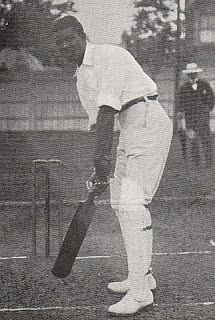
The A-Z of Derbyshire Cricket - O is for Ollivierre: Charles Ollivierre

As was the case with the letter N, finding the best Derbyshire player whose name began with the letter O didn’t give too many options. Still stunned that I could find no room for Kim Barnett ahead of Eddie Barlow, perhaps this is the time to concoct some fictitious Irish roots – Kim O’Barnett, to be sure…
Alas, no and I must be content with the nine names at my disposal that contain largely worthy, if not outstanding players.
There’s Leonard Oliver, a left-handed batsman from Glossop whose career spanned the First World War. He gave decent service over three hundred first-class innings, but an average of a shade over twenty leaves him out of the running.
Moving forward, there’s also Billy Oates, who was solid from the mid-1950s to mid-1960′s without really establishing himself. In 214 innings he reached the fifty mark on 28 occasions, but only twice went on to three figures. A Sheffield man, he was a solid, if unspectacular cricketer who was respected by his colleagues and supporters alike.
Another Yorkshire import who did well for us for a few season was Steve Oldham. ‘Esso’, as he was known from those initials, was a medium-pace bowler who wobbled it around a little and was capable of getting good wickets. He took 273 of them in a career that started at Yorkshire and then enjoy four seasons with us from 1980 to 1983. He was a willing workhorse whose action let him bowl long spells, but his lack of pace saw his annual wicket haul sit around the thirty to forty mark at a cost of over thirty. I liked him as a player, but for me he’s not quite breaking in to the top two.
Second place goes to Tim O’Gorman, a Surrey man who was an exception to my assertion that southern players have rarely made runs up north, certainly not for us. Between 1987 and 1996, O’Gorman was a solid player in the middle order, usually batting at five. He wasn’t the best of starters, but if he got in there were shots around the wicket from a player who was good to watch.
Whenever I think of him, it is for his fifty at Lords against Lancashire, a typically gutsy display that helped to turn around a failing innings and give us a platform from which to build a match-winning score. His retirement for a career outside the game at the age of just 29 took us several seasons from which to recover, but he has made an excellent fist of that career and deserves full credit for it.
My number one? Going back into the mists of time, it is Charles Ollivierre.
 Ollivierre was the first black West Indian to play county cricket. He came to England with the predominantly white West Indies side in 1900 and was the standout batsman with an average of 32. Allowing for the difference in climate and wickets, that was an excellent effort for a 24-year old player. In his game against Derbyshire on that tour, he was dismissed for three in the first innings, but made an unbeaten 23 in the second when opening the innings.
Ollivierre was the first black West Indian to play county cricket. He came to England with the predominantly white West Indies side in 1900 and was the standout batsman with an average of 32. Allowing for the difference in climate and wickets, that was an excellent effort for a 24-year old player. In his game against Derbyshire on that tour, he was dismissed for three in the first innings, but made an unbeaten 23 in the second when opening the innings.
Derbyshire were sufficiently impressed by his displays to ask him to qualify for them and he played as an amateur from 1902, working in the Glossop offices of businessman, politician and Derbyshire player Samuel Hill-Wood. He played some aggressive innings in non-first-class cricket between times, but qualified from July 1902 and averaged 41 that summer.
His second season was the same as that ‘enjoyed’ by others before and since, his average falling to just over twenty as canny bowlers worked him out to some extent. 1904, however, saw him in prime form and 1268 runs flowed from his bat at an average of 35, a number of those innings played on wickets best described as sub-standard.
The highlight was his role in what has been known for decades as ‘Perrin’s match’. It was played at Queen’s Park, Chesterfield, where Ollivierre’s first sight of the town’s crooked spire the previous summer had reputedly seen him dunk his head in a bucket of cold water, thinking he was still the worse for wear from the previous night’s revelry!
The game, between Derbyshire and Essex, was played from July 18-20 in 1904, a Monday to Wednesday. Nonetheless, around two thousand people were present at Chesterfield to see the first day against a strong Essex batting side. None of them could have predicted what was about to unfold.